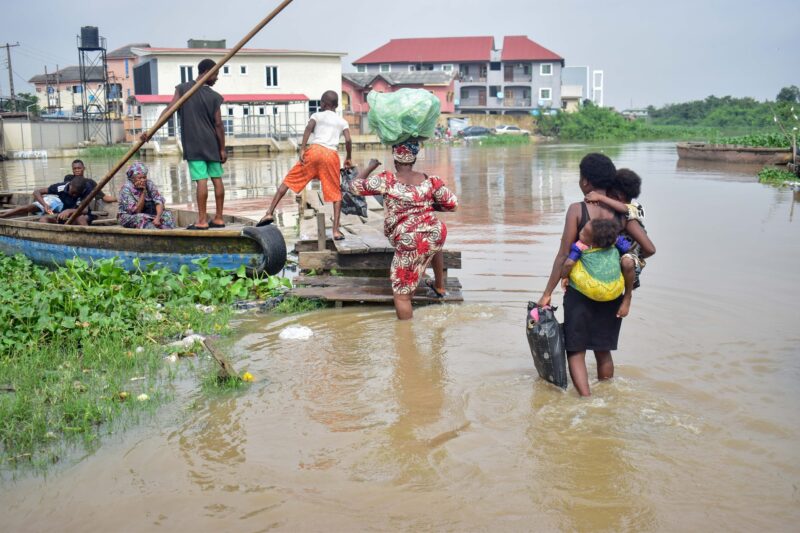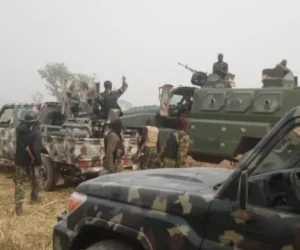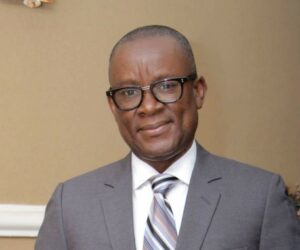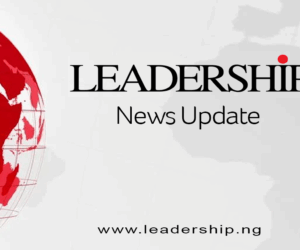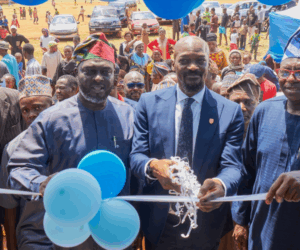Fatima Sulaimon, 35, had her fifth child on a tiny fishing canoe. It happened in the dead of night, five years ago, in Agboyi, a riverine community under the Kosofe Local Government Area of Lagos State.
Agboyi comprises three main areas: Agboyi I, II, and III, all of which are surrounded by the Lagos Lagoon. The settlement suffers severe flooding not just during heavy rains but also when water levels rise or when excess water is released from the Oyan River Dam in Ogun State.
When these waters surge, the streets turn into a dark, impassable lagoon. The only way to reach the mainland is by canoe or boat. When PREMIUM TIMES visited the community on 11 October, this reporter had to navigate the flooded streets wearing high rubber boots, confirming the residents’ daily struggles.
This was the barrier Mrs Sulaimon faced that night.
A night on water
When her labour started around 11 p.m., she was already at the home of a local nurse who served as the community’s birth attendant, a necessity in Agboyi, where hospitals are miles away and primary health centres barely function.
“But the labour became difficult,” she recalled. “The nurse was scared and said she couldn’t handle it.”
Her family began searching desperately for a boat. “They eventually got a fishing canoe to help at 1 a.m.,” she said softly.
As the small canoe rocked on the dark water, Mrs Suleimon struggled through her contractions and delivered the baby herself. They turned back because the hospital was still far away, leaving the nurse to clean up and remove the placenta.
“If not for the flooding in the streets, it would have been easier. Because everywhere was flooded, we couldn’t get anything,” Mrs Sulaimon said.
Minutes lost, lives lost
Accessing immediate specialised care is a challenge for pregnant women in an environment where rising waters turn homes and streets into extensions of the lagoon.
“For an unconscious pregnant woman that we need to rush out for an emergency, we have to look for canoe or boat drivers. This is time-consuming,” said Taibat Salako, a nurse who has served in the Agboyi community for over 15 years.

She recalled a case in May of a woman who died after flooding delayed her transfer to a hospital.
“She had given birth but was bleeding. From 6 a.m., struggling to keep her alive, we arrived at Gbagada by 9 a.m., and she had already given up,” she said.
The Agboyi riverbank to Gbagada General Hospital is about a 20-minute drive.
Elizabeth Ajamobe, another nurse in the community, said when a woman is in labour and complications arise, they immediately ask her to “find a way out of here.”
The constant inundation has forced residents to live in perpetual adaptation, using crates or kegs to raise their belongings.
“For someone who is in labour and is walking gently, it is quite difficult to adapt,” Fatimoh Adetoyi, a resident of Agboyi, said. “Some women give birth on the small walkways we constructed, some give birth inside the boat. We have had cases where we were the ones to rescue them.”

The Baale of Agboyi III, Lateef Adeshina, lamented the despair of the residents. “Particularly, our pregnant women face serious challenges when it is time for them to deliver because we have to get them on a boat to cross quickly. As a result of this, we have lost our loved ones.”
Floods raise mortality risk
Studies have shown that floods do more than destroy property; they endanger women’s lives.
A May 2025 study, titled Flooding and Waterborne Diseases Affecting Pregnant Women in Lagos Slums, found that exposure to unsanitary floodwaters significantly increases the risks of miscarriage, preterm birth, and maternal mortality.
Globally, a 2024 analysis of more than 3,000 studies reported that any flood increases preterm births by about three per cent and raises the risk of low birth weight by seven per cent. Researchers attribute this to stress-induced early labour and the inability to reach healthcare in time to prevent complications.
In Lagos, the scale is high, as confirmed by the 2024 joint post-flood assessment by the International Organisation for Migration (IOM) and National Emergency Management Agency (NEMA), which found that 7,672 pregnant and breastfeeding women were directly affected during the last major flood, including 4,140 pregnant women alone.
The report warned that this group faces “significant health risks” due to limited access to care. The assessment, which covered 81 locations in 14 LGAs, specifically found that Kosofe LGA (home to Agboyi) was the second-worst-hit area in the state, with 31,019 individuals affected.
For 2025, the Nigerian Meteorological Agency (NIMET) projected above-normal rainfall, a trend scientists confirm is due to climate change. The Lagos State Government confirmed this forecast, predicting an average annual rainfall of nearly 2,000 millimetres, significantly higher than the long-term average.
Water, waste, and disease

Each year, as rainfall intensifies, floodwaters mix with sewage and refuse from clogged drains, spreading diseases like cholera.
As of September 2024, Lagos accounted for 60 per cent of Nigeria’s suspected cholera cases, a figure tied to sanitation failure in flood-prone neighbourhoods.
A Lagos-based public health physician, Mariam Oshodi, highlighted the particular danger for pregnant women.
“Flooding directly endangers maternal health and mental well-being, contributing to higher risks of mortality and morbidity. This is an issue that must be addressed urgently,” Mrs Oshodi said.
“It is a profound gendered crisis that demands immediate, gender-responsive climate action and targeted public health interventions.”
Locked health centre

At the heart of Agboyi stands what should have been a symbol of hope: a 40-bed primary healthcare centre completed earlier this year.
Constructed by the Office of the Senior Special Assistant to the President on Sustainable Development Goals (OSSAP-SDGs), led by Adejoke Orelope-Adefulire, a former Deputy Governor of Lagos State, it was meant to serve Agboyi I, II, and III.
But months after completion, the centre remains unopened. Its walkway and ground floor are submerged, doors are locked, and equipment has been pushed upstairs to escape the floodwater.
“They even brought a generator and some hospital equipment,” said Shakiru Olaiya, chairman of the community’s Ward Health Committee. “But since the flood entered, everything has been moved upstairs. We need them to refill and refloor the place so it can start functioning.”
“We want the health centre to start functioning,” Taiwo Lamina, the king of Agboyi II, said. “It will really help us in emergencies. We’ve waited too long.”
When PREMIUM TIMES contacted OSSAP-SDGs, its spokesperson, Desmond Utomwen, confirmed that the centre had been completed but was temporarily inaccessible due to flooding.
“Following a formal request from the people of Agboyi, under the leadership of the Royal Father of the three riverine communities of Agboyi I, II, and III, the OSSAP-SDGs approved and undertook the construction of a Primary Healthcare Centre (PHC) to serve the communities and their surrounding areas,” Mr Utomwen said on 1 November.
“We wish to confirm that the PHC has recently been completed. However, due to the release of water from the Oyan Dam, the community and some neighbouring areas are currently experiencing flooding, which has temporarily affected access to the facility.”
He said officials from both OSSAP-SDGs and the Lagos State government have visited the site and agreed on a lasting solution.
“An elevated platform will be constructed to permanently address the access issue once the water subsides,” he noted.
Floods that never leave
When heavy rainfall coincides with the release of excess water from the Oyan Dam, the river overflows its banks, locking up drainage and trapping Agboyi homes in water.
Joseph Ibrahim, a climate activist and programme manager at the Global Initiative for Food Security and Ecosystem Preservation (GIFSEP), said Lagos’s geography makes it particularly vulnerable.

“The state lies along the coast and is surrounded by rivers and lagoons. As global temperatures rise, evaporation increases, leading to heavier rainfall. Rapid urban development and inadequate drainage mean the city cannot cope,” Mr Ibrahim explained.
He added, “Women and children bear the brunt of such disasters. Lagos needs deliberate investment in flood-resilient infrastructure to protect these vulnerable groups.”
According to Ganiu Ajadi, director of Drainage Construction and Dredging at the Lagos State Ministry of the Environment, flooding is a recurring consequence of the state’s geography and climate.
“Lagos faces seasonal flooding, worsened by water release from the Ogun–Osun River Basin,” he said. “When water levels rise at the lagoon, drainage becomes difficult. We also receive water from Oyo, Osun, and Ogun states, which makes it complex.”
Double burden in Amukoko
In Amukoko, located under the Ajeromi-Ifelodun Local Government Area, the story is similar; however, here the floods bring filth.
Residents say the main canal, which should drain stormwater into the lagoon, has not been dredged in over four years. With every rainfall, water mixed with waste spills into homes and shops, further worsened by a poor drainage system. The most affected streets include Olatunji and Townhall.

“When it rains for 30 minutes, we can’t go out again,” said Temitayo Adigun, who gave birth during one of the floods. “I had to use a traditional birth attendant close by because the health centre wasn’t accessible.”
The Oridilu Primary Health Centre, located directly along a flood-prone street (Town Hall), is also affected and becomes unusable when the community is flooded after heavy rain.

“Even the nurses don’t come when it’s flooded,” said Ramat Jaiyeola. “Last year, a woman selling brooms fell into the canal and died because it was overgrown with weeds. They found her body five days later.”

The Baale of Oridilu, Lateef Olatunji, believes the situation persists due to poor maintenance.
“The government needs strict canal maintenance and enforcement of proper sanitation and waste management,” Mr Olatunji said. “The wooden bridge raised from inside the canal has worsened the situation. We want a motorable bridge.”
Money flows, but water stays
Although residents of Amukoko say recurrent flooding is worsened by a canal that has not been cleared for at least four years, budget records show the Lagos State government has consistently allocated billions for drainage and canal dredging across the state.

Data from the Lagos State Ministry of Economic Planning and Budget indicate that N33.26 billion was approved in 2024 for “Drainage Construction and Dredging (Statewide),” rising to N49.76 billion in 2025.
Other allocations include N14.8 billion for drainage construction and N17.8 billion for dredging.
In 2023, N13.65 billion was earmarked for statewide dredging, with N9.36 billion for drainage construction and maintenance.
READ ALSO: Lake Chad Basin: Repeated flooding weakens already stricken region
In his comments, Mr Ajadi of the Lagos Ministry of Environment confirmed that a contractor has been mobilised to start dredging the canal he identified as Baale Okoya.
“Work is expected to start within two weeks,” he said on 2 November, noting that some delays were due to limited funds.
He added, “Residents often dispose of refuse into canals, which blocks water flow. The government cannot police every area. Communities must also take ownership.”
Still, for many in Amukoko, the gap between state budgets and results remains wide, leaving them to confront floodwaters season after season.
The Lagos State Government often insists that drainage rehabilitation and dredging are ongoing, but the reality in Agboyi and Amukoko tells another story.
For residents, it is difficult to trust promises when they live surrounded by water every year. “We appreciate the government,” said Mr Olatunji of Amukoko. “But until the canal is cleared and the bridge fixed, nothing will change.”
This report is part of Project HER, a collaborative initiative under the Africa Health Communications Fellowship (AHCF) by frayCollege.

